| 1967-69 L6 Engine Stamp Location | 1967-69 V8 Engine Stamp Location | Alternate 1969 V8 VIN location |
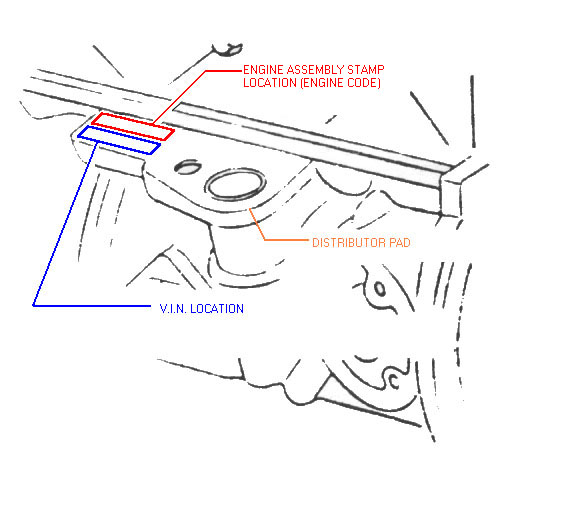 |
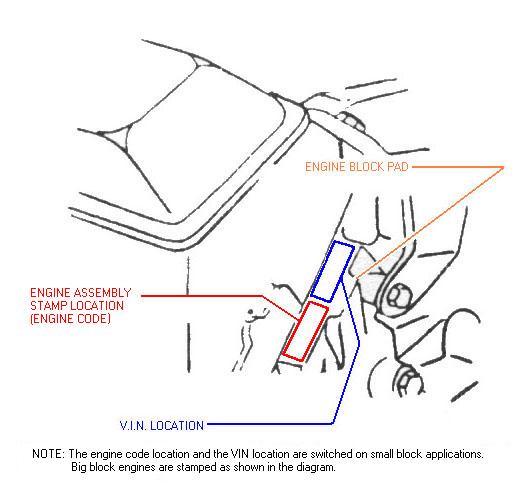 |
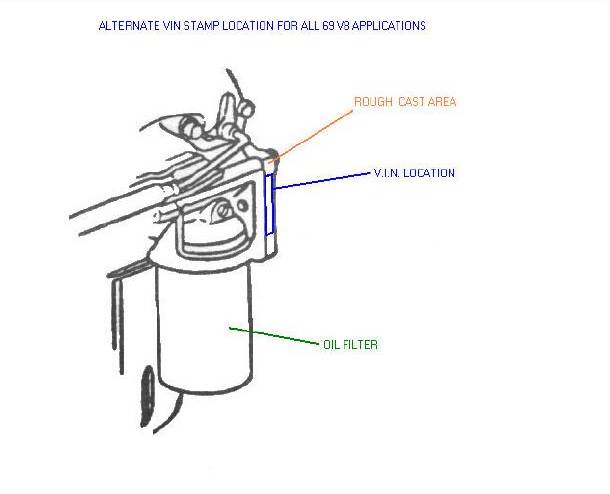 |
| C R G | CRG Reports | Exterior | Engine | 1967 Model ID |
| Numbers Decode | General Info | Interior | Transmission | 1968 Model ID |
| Drivetrain Decode | Options | Underhood | Chassis | 1969 Model ID |
©1998-2025, Camaro Research Group
Edited by Kurt Sonen
Version: Monday, 10-Mar-2025 23:52:09 EDT
| 1967-69 L6 Engine Stamp Location | 1967-69 V8 Engine Stamp Location | Alternate 1969 V8 VIN location |
 |
 |
 |
Engine Code Format: fmmddaa
where f = engine factory code
F for Flint (MI) Motor Facility (L6 engines)
V for Flint (MI) Engine Plant (V8 engines)
T for Tonawanda (NY) Engine Plant
mm = numeric month of year
dd = numeric day of month
aa = engine application suffix code (see tables
below)
Example: V1012FL
This is interpreted as a Camaro 327ci-210HP engine with
the TH350 transmission assembled on October 12th (1968)
at the Flint, MI engine assembly plant for a 1969 model.
|
Automatic 3- or 4-speed
Transmission Transmission
no-A/C A/C no-A/C A/C
------ ------ ------ ------
without K19 (smog)
230ci/140HP base L6 LE LF LA LB
250ci/155HP L22 L6 FM FR LN LO
with K19 (smog)
230ci/140HP base L6 LG LH LC LD
250ci/155HP L22 L6 GP GQ LP LQ
Automatic Manual
----------- ----------
without K19 (smog)
283ci/195HP Swiss * MJ MD
302ci/290HP Z28 -- MO
327ci/210HP base V8 ME MA
327ci/275HP L30 MM MK
350ci/295HP L48 MU MS
396ci/325HP L35 MY MW
396ci/375HP L78 -- MQ
with K19 (smog)
302ci/290HP Z28 -- MP
327ci/210HP base V8 MF MB
327ci/275HP L30 MN ML
350ci/295HP L48 MV MT
396ci/325HP L35 MZ MX
396ci/375HP L78 -- MR
* only used in Camaros built at the GM Suisse plant
and sold in Switzerland.
|
Automatic 3- or 4-speed
Transmission Transmission
no-A/C A/C no-A/C A/C
------ ------ ------ ------
230ci/140HP base L6 BF BH BA BD
250ci/155HP L22 L6 CQ CR CM CN
Automatic Manual
----------- ----------
302ci/290HP Z28 -- MO
327ci/210HP base V8 ME & MI* MA
327ci/275HP L30 EE & EN* EA
350ci/295HP L48 MU & MF* MS
396ci/325HP L35 MY MW
396ci/350HP L34 MR MX
396ci/375HP L78 -- MQ
396ci/375HP L89 -- MT
* Engine code with TH350 transmission, used in
late-year 1968 TH350 test fleet
|
PowerGlide/TD TH350 3- or 4-speed
no-A/C A/C no-A/C A/C no-A/C A/C
------ ------ ------ ------ ------ ------
230ci/140HP base L6 AN AQ AO AR AM AP
230ci Export AT AV -- -- AS AU
250ci/155HP L22 L6 BB BC BD BH BE BF
PowerGlide TH350 3-spd 4-spd
------------- ----------- ------ ------
307ci/200HP base V8 DC DD DA DE
327ci/210HP base V8 FK FL FJ FZ
327ci Export FT -- FS
350ci/250HP L65 HF HD HC
350ci/255HP LM1 HR HS HQ
350ci/300HP L48 HE HB HA
302ci/290HP Z28 -- -- DZ
TH400 Manual
--------- --------
396ci/325HP L35 JG / CJG JB / CJB
396ci/350HP L34 JI / CJI JF / CJF
396ci/375HP L78 JL / CJL JH / CJH
396ci L78 w/ L89 Al heads JM / CJM JJ / CJJ
TH400 4-spd
--------- --------
427ci/425HP L72 COPO 9561 MO MN
427ci/430HP ZL1 COPO 9560 MM ML
Engine Codes Reserved for Use With MA6 Heavy-Duty Clutch
(none produced):
L48 - HP, L35 - JU, L34 - KA, L78 - KC, L89 - KE
|
| Bore | 1967 | 1968 | 1969 | |
|---|---|---|---|---|
| L6 | 3.875" | 3877178 3921968 * |
3921968 | 3921968 |
| 307 | 3.875" | - | - | 3932371 3932373 3956632 3970024 |
| 327 | 4.0" | 3903352 3892657 |
3914660 3914678 |
3932386 3932388 3956618 3970010 3970014 * |
| 302 & 350 | 4.0" | 3892657 | 3914678 | |
| 396 | 4.094" | 3902406 3916323 |
3916323 3935440 |
3935440 3955272 3969854 |
| 427 | 4.251" | - | - | 3963512 |
| * - see note below | ||||
Trans Code Format: tymdds
where:
t = transmission type
MANUAL AUTOMATIC
S = Saginaw 3-speed A = 68/69 L6 Torque-Drive
K = McKinnon 3-speed C = Cleveland Powerglide
H = 69 Muncie HD 3-speed T = Toledo Powerglide
R = 4-speed Saginaw B = Cleveland TH350
P = 4-speed Muncie X = Cleveland TH350
Y = Toledo TH350
y = model year (not calendar year)
m = month
Jan Feb Mar Apr May Jun Jul Aug Sep Oct Nov Dec
--- --- --- --- --- --- --- --- --- --- --- ---
A B C D E H K M P R S T
dd = day of month
s = suffix
PowerGlide and TH350 (not used on all):
D = day shift
N = night shift
1969 Muncie 3-speed
B = 2.42 first gear ratio
1969 Muncie 4-speed only:
A = M20
B = M21 Use of the Muncie type suffix
C = M22 began with 21 Oct 68 production.
Examples:
R7S21 Saginaw 4-speed, Nov 21, 1966
P8R01 Muncie M2x 4-speed, Oct 01, 1967
P9T11B Muncie M21 4-speed, Dec 11, 1968
C9D14N PowerGlide M35 2-speed auto,
Apr 14, 1969, night shift
|
Wmmdd
W = B-W HD 3-speed (67/8)
mm = month
dd = day
Example:
W0224 B-W HD 3-speed, Feb 24
|
|
|
|
|
| Transmission | Case Info | 1967 | 1968 | 1969 |
|---|---|---|---|---|
| Saginaw 3-speed | material: cast iron 7-bolt side cover |
3859986 | 3925647 | |
| H-D 3-Speed | material: cast iron 9-bolt side cover (B-W) 7-bolt side cover (MC1) |
Borg-Warner M13 T16-1 |
Muncie MC1 # 3911982 3911940 | |
| Saginaw 4-speed | material: cast iron 7-bolt side cover |
3915032 | 3925656 | |
| Muncie 4-speed | material: aluminum 7-bolt side cover |
3885010 | 3925660 * | |
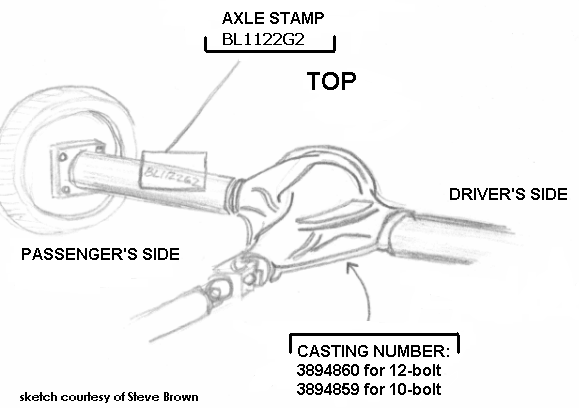
|
|
|
Axle Code Format: aa mmdd fs
p
where:
aa = application code - two alphabetic characters
mm = two-digit numeric month (01-12)
dd = two-digit numeric day of month (01-31)
f = factory plant code
G - Detroit Gear & Axle plant
s = shift code (1 or 2)
p = a positraction manufacturer code, when applicable,
is added on a second line. The posi manufacturer
codes are D for Dana, E for Eaton, and W for
Warner.
Example: BL 1122 G2
For a 68 or 69 model, this is interpreted as a
3.07:1 axle ratio, non-posi, 12-bolt rear
axle assembled on November 22, 67 or 68 by the
Detroit Gear & Axle plant, second shift.
|
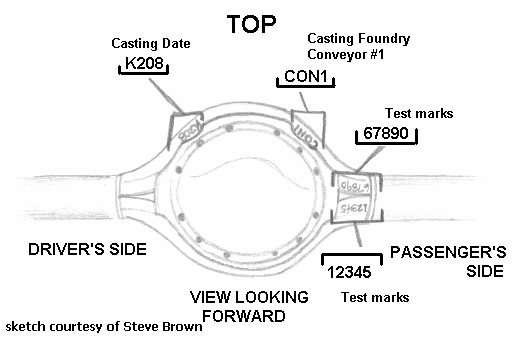
|
mddy
where:
m = month (A-L month format, see below)
dd = 1- or 2-digit numeric day of month (1-31)
y = last digit of calendar year
Jan Feb Mar Apr May Jun Jul Aug Sep Oct Nov Dec
A B C D E F G H I J K L
|
Note: late 69 axles often are stamped with a C preceding the axle code (a 1970 feature), e.g. CBT instead of just BT.
| 1967 | 1968 | 1969 * | ||||||||||
|---|---|---|---|---|---|---|---|---|---|---|---|---|
| Code | Ratio | Size | Type | Brake | Ratio | Size | Type | Brake | Ratio | Size | Type | Brake |
| BA | 2.56 | 10 | N | 2.56 | 10 | N | ||||||
| BB | 2.56 | 10 | P | 2.56 | 10 | P | ||||||
| BC | 3.36 | 10 | N | 3.36 | 10 | N | ||||||
| BD | 3.36 | 10 | P | 3.36 | 10 | P | ||||||
| BE | 2.56 | 12 | N | 4.10 | 12 | P | ||||||
| BF | 2.56 | ? | N | |||||||||
| BG | 2.56 | 12 | P | |||||||||
| BH | 2.56 | ? | P | |||||||||
| BI | 2.73 | 12 | N | 2.73 | 12 | N | ||||||
| BJ | 3.07 | 12 | N | STD | 3.07 | 12 | N | |||||
| BK | 2.73 | 10 | N | STD | 2.73 | 10 | N | |||||
| BL | 3.07 | 12 | N | 3.07 | 12 | N | ||||||
| BM | 3.31 | 12 | N | 3.31 | 12 | N | ||||||
| BN | 3.55 | 12 | N | 3.55 | 12 | N | ||||||
| BO | 3.73 | 12 | N | 3.73 | 12 | N | ||||||
| BP | 3.08 | 10 | N | STD | 2.73 | 10 | N | 2.73 | 10 | N | ||
| BQ | 2.73 | 12 | P | 2.73 | 12 | P | ||||||
| BR | 3.07 | 12 | P | 3.07 | 12 | P | ||||||
| BS | 3.31 | 12 | P | 3.31 | 12 | P | ||||||
| BT | 3.55 | 12 | P | 3.55 | 12 | P | ||||||
| BU | 3.73 | 12 | P | 3.73 | 12 | P | ||||||
| BV | 4.10 | 12 | P | 4.10 | 12 | P | ||||||
| BW | 4.56 | 12 | P | 4.56 | 12 | P | ||||||
| BX | 4.88 | 12 | P | 4.88 | 12 | P | ||||||
| BY | 2.73 | 12 | P | |||||||||
| BZ | 2.73 | 12 | N | |||||||||
| PA | 3.08 | 10 | N | STD | 3.08 | 10 | N | 3.08 | 10 | N | ||
| PB | 3.36 | 10 | N | STD | 3.31 | 12 | N | 2.56 | 10 | N | ||
| PC | 3.31 | 12 | N | STD | 3.31 | 12 | N | 2.56 | 10 | P | ||
| PD | 3.07 | 12 | P | STD | 3.31 | 12 | P | 2.73 | 10 | N | ||
| PE | 3.08 | 10 | P | STD | 3.08 | 10 | P | 3.08 | 10 | P | ||
| PF | 3.31 | 12 | P | STD | 3.31 | 12 | P | 2.73 | 10 | P | ||
| PG | 3.36 | 10 | P | STD | 3.07 | 12 | P | 3.08 | 10 | N | ||
| PH | 3.55 | 10 | P | STD | 3.55 | 10 | P | 3.55 | ? | N | ||
| PI | 3.55 | 12 | P | STD | 3.55 | 12 | P | 2.56 | 10 | N | ||
| PJ | 3.73 | 12 | P | STD | 3.73 | 12 | P | 2.56 | 10 | P | ||
| PK [1] | 3.55 | 10 | N | STD | 3.55 | 10 | N | 3.55 | ? | N | ||
| PL | 3.55 | 12 | N | STD | 3.55 | 10 | N | 2.73 | 10 | N | ||
| PM | 3.73 | 12 | N | STD | 3.73 | 12 | N | 2.73 | 10 | P | ||
| PN | 3.07 | 12 | N | MET | 2.56 | 12 | N | 3.08 | 10 | P | ||
| PO | 3.07 | 12 | P | MET | 2.56 | 12 | P | MET | 3.08 | 10 | N | |
| PP | 3.31 | 12 | N | MET | 3.07 | 12 | N | 3.36 | 10 | N | ||
| PQ | 3.55 | 12 | N | MET | ||||||||
| PR | 3.31 | 12 | P | MET | 3.31 | 12 | P | 3.08 | 10 | P | ||
| PS | 3.55 | 12 | P | MET | 3.55 | 12 | P | 3.36 | 10 | P | ||
| PT | 3.73 | 12 | N | MET | 3.73 | 12 | N | 3.36 | 10 | N | ||
| PU | 3.73 | 12 | P | MET | 3.73 | 12 | P | 3.36 | 10 | P | ||
| PV | 3.07 | 12 | N | STD | ||||||||
| PW | 2.73 | 10 | N | STD | ||||||||
| PX | 2.73 | 10 | P | STD | 2.73 | 10 | P | 2.73 | 10 | P | ||
| PY | 2.73 | 12 | P | STD | 2.56 | 12 | N | 2.56 | 12 | N | ||
| PZ | 2.73 | ? | N | STD | 2.56 | 12 | P | 2.56 | 12 | P | ||
| QA | 4.10 | 12 | P | STD | 4.10 | 12 | P | |||||
| QB | 4.56 | 12 | P | STD | 4.56 | 12 | P | |||||
| QC | 4.88 | 12 | P | STD | 4.88 | 12 | P | |||||
| QD | 2.73 | 10 | N | MET | 4.10 | 12 | P | |||||
| QE | 2.73 | 10 | P | MET | 3.55 | ? | ? | |||||
| QF | 4.10 | 12 | P | MET | 4.10 | 12 | P | |||||
| QG | 4.56 | 12 | P | MET | 4.56 | 12 | P | |||||
| QH | 4.88 | 12 | P | MET | 4.88 | 12 | P | |||||
| QI | 2.73 | 12 | P | STD | 2.73 | 12 | P | |||||
| QJ | 3.07 | 12 | P | STD | 3.07 | 12 | P | |||||
| QK | 3.31 | 12 | P | STD | 3.31 | 12 | P | |||||
| QL | 3.31 | 12 | N | STD | 3.31 | 12 | N | |||||
| QM | 2.73 | 12 | P | MET | 4.88 | 12 | P | |||||
| QN | 2.73 | 12 | N | MET | 4.88 | 12 | P | 4WD | 4.88 | 12 | P | 4WD |
| QO | 3.07 | 12 | N | MET | 3.07 | 12 | N | |||||
| QP | 3.07 | 12 | P | MET | 3.07 | 12 | P | |||||
| 3.31 | 12 | N | MET | 3.31 | 12 | N | ||||||
| QR | 3.31 | 12 | P | MET | 3.31 | 12 | P | |||||
| QS | 3.07 | 12 | N | STD | 2.56 | ? | P | 4WD | 2.56 | 12 | P | 4WD |
| QT [2] | 2.73 | 12 | N | STD | 2.73 | 10 | N | 4WD | 2.73 | 12 | P | 4WD |
| QU | 2.73 | 12 | P | STD | 3.07 | 12 | P | 4WD | 3.07 | 12 | P | 4WD |
| QV | 2.73 | 10 | N | MET | 3.31 | 12 | N | 4WD | 3.31 | 12 | P | 4WD |
| QW | 3.07 | 12 | P | STD | 3.55 | 12 | P | 4WD | 3.55 | 12 | P | 4WD |
| QX | 2.73 | ? | P | MET | 3.73 | 12 | N | 4WD | 3.73 | 12 | P | 4WD |
| QY | 3.07 | 12 | N | MET | 4.10 | 12 | P | 4WD | 4.10 | 12 | P | 4WD |
| QZ | 3.07 | 12 | P | MET | 4.56 | 12 | P | 4WD | 4.56 | 12 | P | 4WD |
| Axle codes Q2 through Q9 also appear in some documentation for 1968 usage. These Q2-Q9 codes have not been observed in any vehicles but are mentioned for completeness. |
|
||||
|
|
|
|
|